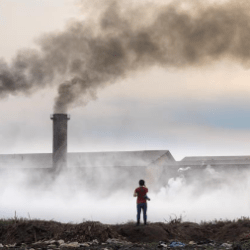While outdoor air pollution is pervasive, poor air quality also poses severe health risks inside people’s homes. Indoor air pollution results from the burning of solid fuels like coal, wood, dung, or crop waste for cooking, lighting, and heating (Ritchie and Roser 2022).

The combustion of such substances releases various pollutants that are harmful to human health. As with ambient air pollution, long-term exposure to these pollutants increases the risk of life-threatening diseases, making indoor air pollution one of the leading global environmental risk factors (Murray et al. 2020). Global estimates of premature deaths caused by indoor air pollution are similar in number to those caused by outdoor air pollution. The World Health Organization (WHO 2022) estimates that nearly 4 million people die annually from exposure to indoor air pollution, compared to the 4.2 million deaths from ambient air pollution in 2016 (WHO 2021a). The Global Burden of Disease study estimates that 2.3 million and 4.5 million premature deaths result from exposure to indoor and outdoor air pollution, respectively, each year (IHME 2020). Map B2.3.1 shows the global distribution of death rates from indoor air pollution in 2019.

Indoor air pollution poses particular health risks to people in low- and middle-income countries and vulnerable groups like children, women, the sick, and the elderly. The vast majority of deaths due to indoor air pollution—that is, 81 percent (or 1.8 million deaths)—occur in low- or lower-middle-income countries, especially in South Asia and Sub-Saharan Africa (IHME 2020). Globally, progress has been made in reducing deaths due to indoor air pollution, as the number of annual premature deaths was halved between 1990 and 2019. Yet improvements have been significantly smaller in Sub Saharan Africa, where the annual number of deaths from indoor air pollution declined by only 15 percent in the same time frame (Ritchie and Roser 2022). Map B2.3.1 highlights the above-average mortality from air pollution in Sub-Saharan Africa and South Asia. Indoor air pollution disproportionately affects poor people. Households that cannot afford clean cooking and heating fuels, like electricity or natural gas, are forced to use polluting solid fuels instead. Figure B2.3.1 summarizes the WHO’s Energy Ladder, which highlights the higher dependency of poor households on toxic fuels. According to World Bank data, about 3 billion people—40 percent of the world’s population—still lack access to modern energy sources for their home use (Ritchie, Roser, and Rosado 2020). In low- and lower-middle-income countries, the use of dirtier, unsafe solid fuels is more prevalent, and the death rate from indoor air pollution is higher. This situation highlights the risk that removing subsidies on relatively clean-burning fossil fuels, such as liquefied petroleum gas, will force households to switch to cheaper polluting biomass fuels.
Reference: World Bank https://openknowledge.worldbank.org/server/api/core/bitstreams/61d04aca-1b95-4c06-8199-3c4a423cb7fe/content













